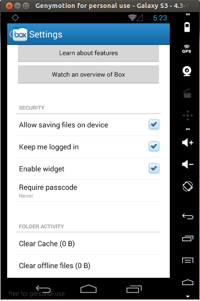

- #Pinbox for android how to
- #Pinbox for android archive
- #Pinbox for android for android
- #Pinbox for android code
If ProGuard (or any other shrinking/obfuscation mechanism) is used as a build step, This will ensure that your module compiles with the MAM SDK when you build your project.
#Pinbox for android code
Right-click the module or modules containing your app code and go to Module Settings > Dependencies tab > + icon > Module dependency > Select the MAM SDK AAR module you just created > OK.
#Pinbox for android archive
Then select our Android archive package .aar to create a module for the. To do this, open your app project in Android Studio and go to File > New > New module and select Import. aar must be specified as an Android library reference. aar contains both the interfaces necessary for an app protection policy enablement and the code necessary to interoperate with the Microsoft Intune Company Portal app. The Intune App SDK is a standard Android library with no external dependencies.
#Pinbox for android how to
Sample appsĮxamples of how to integrate with the Intune App SDK properly include:
#Pinbox for android for android
Regularly check the Intune App SDK for Android for updates and incorporate into your software development release cycle to ensure your apps support the latest App Protection Policy settings.

Intune regularly releases updates to the Intune App SDK. When the app initializes, it loads policy and code to enforce that policy from the Company Portal. The Company Portal retrieves app protection policies from the Intune service. The Intune App SDK for Android relies on the presence of the Company Portal app on the device to enable app protection policies. Apps are expected to use AndroidX (eitherĭirectly or through the Jetifier) if they need support library If your app declares minSdkVersion to an API levelīelow API 23, the MAM SDK will not block app usage for users who areįrom Intune APP SDK 8.0.0 onwards, the legacy Android Support Library MAM usage and the Company Portal are not supported belowĪndroid API 23. In order to target Android API 31, you must The SDK fully supports Android API 28 (Android 9.0) through AndroidĪPI 31 (Android 12.0). THIRDPARTYNOTICES.TXT: An attribution notice that acknowledges third-party and/or OSS code that will be compiled into your app.CHANGELOG.md: Provides a record of changes made in each SDK version..build.jar: A Gradle plugin, which aids in integrating the SDK.The AARĬontains ProGuard rules to exclude all its classes. MAMActivity, and most apps do not need to include it. If your app performs reflection on classes deriving from Newerĭevices will ignore these stub classes. Stubs for Android system classes, which are present only on newerĭevices, but which are referenced by methods in MAMActivity. .DownlevelStubs.aar: This AAR contains..aar: The SDK components, except for the Support Library JAR files.

The Intune App SDK consists of the following files: Intune administrators can easily deploy app protection policies to your Intune-managed app when Intune actively manages the app. An Intune-managed application is one that is integrated with the Intune App SDK. The Microsoft Intune App SDK for Android lets you incorporate Intune app protection policies (also known as APP or MAM policies) into your native Android app. If you have issues with integrating the Intune App SDK into your apps, submit a request for assistance on GitHub. To download the SDK, see Download the SDK files. You might want to first read the Intune App SDK overview, which covers the current features of the SDK and describes how to prepare for integration on each supported platform.


 0 kommentar(er)
0 kommentar(er)
